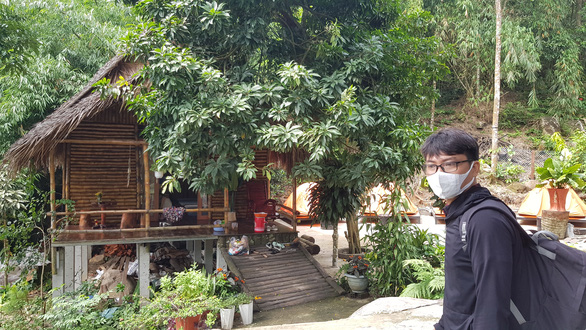As post-COVID-19 tourism booms, the homestay industry on Cam (Forbidden) Mountain in An Giang Province is ballooning to meet demand despite provincial regulations forbidding new tourism-related construction.
While homestay owners look to cash-in on the boom, other residents in the province, located in Vietnam's Mekong Delta region, worry that rampant, unchecked construction could negatively impact the local way of life.
The area near Cam Mountain, in particular, is a homestay hotbed, with the neighborhoods near Thuy Liem Lake and the Maitreye Buddha statue boasting at least seven homestays that are currently in operation and several households that appear to be making preparations to build more facilities ahead of the summer rush.
More money, no problems
Nguyen Thanh Tung, who owns Mai Tung Homestay, opened his five-room service behind the giant Buddha statue at beginning of the year.
The majority of his guests are young people visiting the area to explore the forest and local mountainous landscapes.
Room rates at Tung’s homestay are VND300,000-450,000 (US$12.8-19.2) per night.
“I was given a VND4 million [$171] fine for the illegal construction [of my homestay], but my business is thriving and authorities have otherwise left me alone,” Tung said.
S., the owner of another homestay near Cam Mountain, recently built four wooden rooms and a big stilt house for travelers.
“I was asked to pay a VND4 million fine when I began building [my homestay]. I accepted the penalty because I believe that tourism is profitable,” S. said.
“Local authorities should make it easier for residents to get involved in the tourist industry.”
Most of the homestays near Cam Mountain use tents with beds and pillows, rather than traditional rooms, to house guests.
“Our guests pay VND300,000 to VND500,000 [$21.4] per day for a tent. That doesn’t include meals,” said Si, the owner of Phu Si Homestay.
Though Si’s homestay is relatively modest, it does offer running water, electricity, and Wi-Fi to guests.
According to an official on the Cam Mountain tourist site management board, the area’s growing popularity amongst tourists is owed to the local landscapes and cuisine.
Unfortunately, a 20-year ban on building new houses and tourist accommodations in the province has stunted the area's tourism growth.
“Solutions for improving the local tourism industry are suggested year after year, but how can the sector develop unless more accommodation is built near the mountain?” the official said.
“In my opinion, if homestays built using bamboo, wood, and leaves are popular with tourists, the local government should support the construction of such facilities.”
Flexible management
Tran Minh Hoa, head of the economic-infrastructure bureau of An Giang’s Tinh Bien District, said many local residents have switched to tourism, and more and more homestays are popping up on the mountain.
Among the seven homestays Hoa is aware of, two feature rooms with electricity and bathrooms. The others are still adding such amenities.
“I hope the residents on Cam Mountain can improve tourism standards. I suggest that the Tinh Bien People’s Committee allow the use of simple materials for homestay construction," Hoa said.
“It’s important for homestays to be able to provide amenities such as running water and toilets."
Le Trung Hieu, director of An Giang’s Trade and Investment Promotion Center, said that Cam Mountain, the highest of the Bay Nui (Seven Mountains), is ideal for tourism development thanks to its cool climate and variety of local fruits.
“Some households there have been successful with homestay business developed on their own land and are able to bring in lots of tourists," Hieu said.
"If the provincial government provides the right incentives, the area will grow in the future.”
Like us on Facebook or follow us on Twitter to get the latest news about Vietnam!

















































